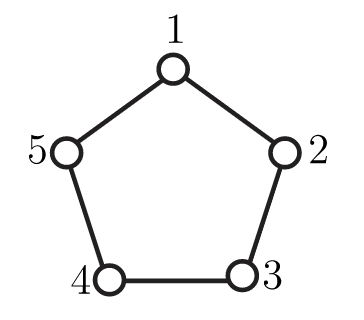15.6: Exercises
( \newcommand{\kernel}{\mathrm{null}\,}\)
1. Write the permutations shown below in cycle notation.
\begin{pmatrix}
1 & 2 & 3 & 4 & 5 & 6 \
4 & 2 & 5 & 6 & 3 & 1
\end{pmatrix}
2. Compute
3. Find
4. In Figure 15.15, we show a regular pentagon with its vertices labeled. Use this labeling to complete this exercise.

Figure 15.15. A pentagon with labeled vertices
a. The dihedral group of the pentagon,
b. Suppose we are coloring the vertices of the pentagon using black and white. Draw the colorings fixed by
c. Find
d. Find the cycle index of
e. Use the cycle index to determine the number of nonequivalent colorings of vertices of the pentagon using black and white.
f. Making an appropriate substitution for the
5. Write all permutations in
6. The 12-note western scale is not the only system on which music is based. In classical Thai music, a scale with seven equally-spaced notes per octave is used. As in western music, a scale is a subset of these seven notes, and two scales are equivalent if they are transpositions of each other. Find the number of
7. Xylene is an aromatic hydrocarbon having two methyl groups (and four hydrogen atoms) attached to the hexagonal carbon ring. How many isomers are there of xylene?
8. Find the permutations in
9. Draw the three nonisomorphic graphs on four vertices with 3 edges and the two nonisomorphic graphs on four vertices with 4 edges.
10.
a. Use the method of Subsection 15.5.3 to find the cycle index of the pair group
b. Use the cycle index from Item 15.6.10.a to determine the number of nonisomorphic graphs on five vertices. How many of them have 6 edges?
11. Tic-tac-toe is a two-player game played on a 9×9 grid. The players mark the squares of the grid with the symbols X and O. This exercise uses Pólya's enumeration theorem to investigate the number of different tic-tac-toe boards. (The analysis of games is more complex, since it requires attention to the order the squares are marked and stopping when one player has won the game.)

Figure 15.16. Numbered squares of a tic-tac-toe board
a. Two tic-tac-toe boards are equivalent if one may be obtained from the other by rotating the board or flipping it over. (Imagine that it is drawn on a clear piece of plastic.) Since the 9×9 grid is a square, the group that acts on it in this manner is the dihedral group
Write each of the eight elements of
b. Find the cycle index of
c. Make an appropriate substitution for
d. How many nonequivalent tic-tac-toe boards are there?
e. How many nonequivalent tic-tac-toe boards have three X's and three O's?
f. When playing tic-tac-toe, the players alternate turns, each drawing their symbol in a single unoccupied square during a turn. Assuming the first player marks her squares with X and the second marks his with O, then at each stage of the game there are either the same number of X's and O's or one more X than there are O's. Use this fact and
12. Suppose you are painting the faces of a cube and you have white, gold, and blue paint available. Two painted cubes are equivalent if you can rotate one of them so that all corresponding faces are painted the same color. Determine the number of nonequivalent ways you can paint the faces of the cube as well as the number having two faces of each color.
- Hint
-
It may be helpful to label the faces as U (“up”), D (“down”), F (“front”), B (“back”), L (“left”), and R (“right”) instead of using integers. Working with a three-dimensional model of a cube will also aid in identifying the permutations you require.


